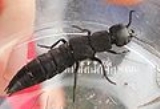
Devil's coach horse beetle
Encyclopedia
The Devil's coach-horse beetle (Ocypus olens) is a very common and widespread Europe
an beetle
, belonging to the large family of the rove beetle
s (Staphylinidae). It was originally included in the genus Staphylinus
in 1764, and some authors and biologists still use this classification. The species has also been introduced to the Americas
and parts of Australasia
.
This black beetle usually shelters during the day under stones, logs or leaf litter. It is most often seen in forests, parks and gardens between April and October.
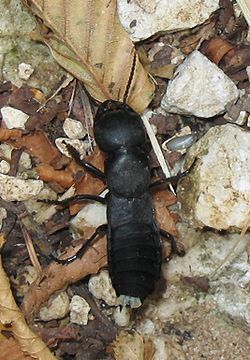 It is a long-bodied beetle. At about 25–28 mm (0.984251968503937–1.1 ) it is one of the larger British beetles. Its wing covers (elytra) are short covering only its thorax
It is a long-bodied beetle. At about 25–28 mm (0.984251968503937–1.1 ) it is one of the larger British beetles. Its wing covers (elytra) are short covering only its thorax
, exposing the abdominal segments. The abdominal musculature is powerful and the abdominal segments are covered with sclerotized plates. It is capable of flight but its wings are rarely used. It is covered with fine black hairs.
It is well known for its habit of raising its long and uncovered abdomen and opening its jaws, rather like a scorpion
when threatened. This explains one of its alternative names, the cock-tail beetle. Although it has no sting, it can give a painful bite with its strong pincer-like jaws. It also emits a foul smelling odour, as a defensive secretion, from a pair of white glands at the end of its abdomen.
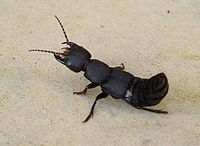
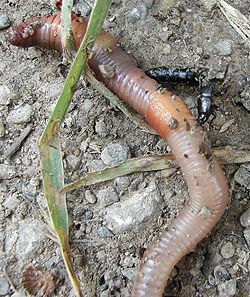 It is a predator, hunting mainly by night, feeding on invertebrates including worm
It is a predator, hunting mainly by night, feeding on invertebrates including worm
s and woodlice
, as well as carrion. The prey is caught in the mandibles which are also used to cut and together with the front legs to manipulate the food into a bolus. The bolus is repeatedly chewed and swallowed, emerging covered with a brown secretion from the foregut, until it is reduced to a liquid which is digested. Skin (in the case of earth worms) and hard materials (from arthropod
s) are left. The larva
e are also carnivorous with similar eating habits.
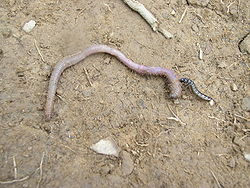 Females lay their eggs from 2-3 weeks after first mating. They are large (4 millimetre or 0.15748031496063 in) and white with a darker band and laid singly in damp conditions under moss, stones, cow pats or leaf litter, typically in the Autumn. After around 30 days the eggs split and the larvae emerge, white with a straw coloured head. The larva lives largely underground, and feeds on similar prey to the adult and has the same well developed mandibles. It adopts the same display with open jaws and raised tail when threatened. The larva goes through three stages of growth (instar
Females lay their eggs from 2-3 weeks after first mating. They are large (4 millimetre or 0.15748031496063 in) and white with a darker band and laid singly in damp conditions under moss, stones, cow pats or leaf litter, typically in the Autumn. After around 30 days the eggs split and the larvae emerge, white with a straw coloured head. The larva lives largely underground, and feeds on similar prey to the adult and has the same well developed mandibles. It adopts the same display with open jaws and raised tail when threatened. The larva goes through three stages of growth (instar
s) the final stage ranging from 20 to 26 mm in length. At around 150 days the larva pupates for about 35 days and emerges as an adult with its final colouring, fully formed except for the wings which cannot be folded neatly beneath the elytra for several hours. Adults can survive a second winter, some by hibernating in burrows and not emerging until March while others remain active.
since the Middle Ages
, hence its common name. Other names include Devil's footman, Devil's coachman and Devil's steed. In Irish
, the beetle is called ("Devil's beast"); "it is said that the Devil assumes the form of this beetle to eat sinners".
Europe
Europe is, by convention, one of the world's seven continents. Comprising the westernmost peninsula of Eurasia, Europe is generally 'divided' from Asia to its east by the watershed divides of the Ural and Caucasus Mountains, the Ural River, the Caspian and Black Seas, and the waterways connecting...
an beetle
Beetle
Coleoptera is an order of insects commonly called beetles. The word "coleoptera" is from the Greek , koleos, "sheath"; and , pteron, "wing", thus "sheathed wing". Coleoptera contains more species than any other order, constituting almost 25% of all known life-forms...
, belonging to the large family of the rove beetle
Rove beetle
The rove beetles are a large family of beetles, primarily distinguished by their short elytra that leave more than half of their abdomens exposed. With over 46,000 species in thousands of genera, the group is the second largest family of beetles after the Curculionidae...
s (Staphylinidae). It was originally included in the genus Staphylinus
Staphylinus
Staphylinus is a genus of rove beetles.-Selected species from Europe:*S. agarici*S. alatus*S. anceps*S. angustatus*S. arnicae*S. biclavatus*S. bicolor*S. brevipes*S. caesareus*S. cantharellus...
in 1764, and some authors and biologists still use this classification. The species has also been introduced to the Americas
Americas
The Americas, or America , are lands in the Western hemisphere, also known as the New World. In English, the plural form the Americas is often used to refer to the landmasses of North America and South America with their associated islands and regions, while the singular form America is primarily...
and parts of Australasia
Australasia
Australasia is a region of Oceania comprising Australia, New Zealand, the island of New Guinea, and neighbouring islands in the Pacific Ocean. The term was coined by Charles de Brosses in Histoire des navigations aux terres australes...
.
This black beetle usually shelters during the day under stones, logs or leaf litter. It is most often seen in forests, parks and gardens between April and October.
Description

Thorax (insect anatomy)
The thorax is the mid section of the insect body. It holds the head, legs, wings and abdomen. It is also called mesosoma in other arthropods....
, exposing the abdominal segments. The abdominal musculature is powerful and the abdominal segments are covered with sclerotized plates. It is capable of flight but its wings are rarely used. It is covered with fine black hairs.
It is well known for its habit of raising its long and uncovered abdomen and opening its jaws, rather like a scorpion
Scorpion
Scorpions are predatory arthropod animals of the order Scorpiones within the class Arachnida. They have eight legs and are easily recognized by the pair of grasping claws and the narrow, segmented tail, often carried in a characteristic forward curve over the back, ending with a venomous stinger...
when threatened. This explains one of its alternative names, the cock-tail beetle. Although it has no sting, it can give a painful bite with its strong pincer-like jaws. It also emits a foul smelling odour, as a defensive secretion, from a pair of white glands at the end of its abdomen.

Diet

Worm
The term worm refers to an obsolete taxon used by Carolus Linnaeus and Jean-Baptiste Lamarck for all non-arthropod invertebrate animals, and stems from the Old English word wyrm. Currently it is used to describe many different distantly-related animals that typically have a long cylindrical...
s and woodlice
Woodlouse
A woodlouse is a crustacean with a rigid, segmented, long exoskeleton and fourteen jointed limbs...
, as well as carrion. The prey is caught in the mandibles which are also used to cut and together with the front legs to manipulate the food into a bolus. The bolus is repeatedly chewed and swallowed, emerging covered with a brown secretion from the foregut, until it is reduced to a liquid which is digested. Skin (in the case of earth worms) and hard materials (from arthropod
Arthropod
An arthropod is an invertebrate animal having an exoskeleton , a segmented body, and jointed appendages. Arthropods are members of the phylum Arthropoda , and include the insects, arachnids, crustaceans, and others...
s) are left. The larva
Larva
A larva is a distinct juvenile form many animals undergo before metamorphosis into adults. Animals with indirect development such as insects, amphibians, or cnidarians typically have a larval phase of their life cycle...
e are also carnivorous with similar eating habits.
Reproduction

Instar
An instar is a developmental stage of arthropods, such as insects, between each molt , until sexual maturity is reached. Arthropods must shed the exoskeleton in order to grow or assume a new form. Differences between instars can often be seen in altered body proportions, colors, patterns, or...
s) the final stage ranging from 20 to 26 mm in length. At around 150 days the larva pupates for about 35 days and emerges as an adult with its final colouring, fully formed except for the wings which cannot be folded neatly beneath the elytra for several hours. Adults can survive a second winter, some by hibernating in burrows and not emerging until March while others remain active.
Superstition
This beetle has been associated with the DevilDevil
The Devil is believed in many religions and cultures to be a powerful, supernatural entity that is the personification of evil and the enemy of God and humankind. The nature of the role varies greatly...
since the Middle Ages
Middle Ages
The Middle Ages is a periodization of European history from the 5th century to the 15th century. The Middle Ages follows the fall of the Western Roman Empire in 476 and precedes the Early Modern Era. It is the middle period of a three-period division of Western history: Classic, Medieval and Modern...
, hence its common name. Other names include Devil's footman, Devil's coachman and Devil's steed. In Irish
Irish language
Irish , also known as Irish Gaelic, is a Goidelic language of the Indo-European language family, originating in Ireland and historically spoken by the Irish people. Irish is now spoken as a first language by a minority of Irish people, as well as being a second language of a larger proportion of...
, the beetle is called ("Devil's beast"); "it is said that the Devil assumes the form of this beetle to eat sinners".

